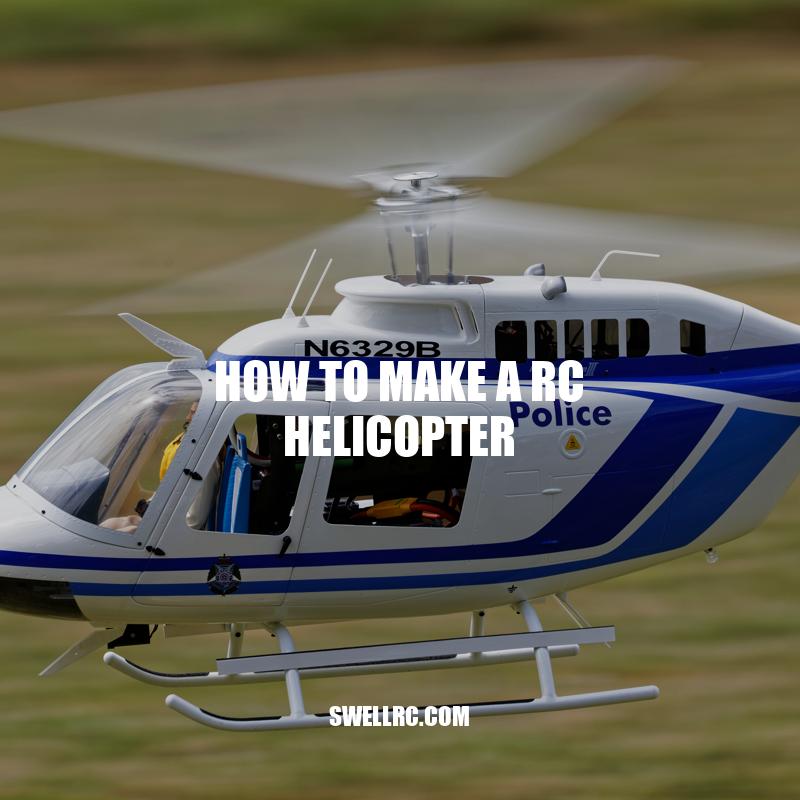DIY Guide: How to Make a RC Helicopter in Easy Steps
Radio-controlled (RC) helicopters have become increasingly popular among hobbyists and enthusiasts looking for a fun and challenging activity. While buying an RC helicopter is an option, building one from scratch can be a gratifying experience that provides a deeper understanding and connection to the craft. Building an RC helicopter may seem daunting, especially if it’s your first time, but following a step-by-step guide can make it achievable. This article aims to guide you in making an RC helicopter by breaking down the process into manageable steps. With the right tools, materials, and patience, you too can learn how to build and customize an RC helicopter that suits your preferences and flying style. Whether you’re a beginner or a seasoned hobbyist, making your own RC helicopter can be a rewarding and enjoyable experience that can bring endless hours of fun and entertainment. So grab your tools, let’s get started, and see the magic of your own creation take flight in no time!
Gathering the Materials
Before we start building the RC helicopter, we need to gather all the necessary materials. Here are the items you will need:
- RC Helicopter Kit
- Transmitter and Receiver
- Brushless Motor
- Motor Shaft
- ESC (Electronic Speed Controller)
- Battery
- LiPo Battery Charger
- Servo
- Wire Connectors
- Connectors Kit
- Propellers
- Tail Rotor Blades
- Canopy
- Landing Gear
- Adhesive Tape
- Soldering Equipment
You can purchase these items online or from your local RC hobby shop. It’s important to get high-quality materials to ensure your RC helicopter‘s safety and durability.
There are several websites where you can purchase RC helicopter kits and components, such as:
What materials do you need to make a helicopter?
To make a helicopter, you need the following materials:
- Aluminum or titanium for the main body
- Fiberglass or carbon fiber for the blades
- Plexiglass or polycarbonate for the windshield
- Copper or brass for electrical components
- Steel or titanium for the landing gear
Keep in mind that the materials required may vary depending on the type and size of the helicopter being built. If you’re interested in learning more about building a helicopter, websites like homebuiltrovs.com and kitplanes.com offer resources and products to help get you started.
Building the Frame
The first step in building an RC helicopter is to assemble the frame. Here are the steps you need to follow:
- Connect the skids to the base frame using screws and nuts.
- Install the tail boom, tail rotor gearbox, and the tail rotor shaft to the tail fin, using adhesive.
- Assemble the main frame by connecting the two side frames with cross braces, using adhesive or screws.
- Attach the landing gear to the main frame, using screws and nuts.
- Install the motor mount to the main frame, using bolts.
Here are some interesting facts about RC helicopter frames:
| Component | Material | Function |
|---|---|---|
| Skids | Carbon fiber or aluminum | Support the helicopter during takeoff and landing |
| Tail boom | Carbon fiber | Holds and rotates the tail rotor |
| Main frame | Aluminum or carbon fiber | Supports all the components and the battery |
| Landing gear | Aluminum or plastic | Supports the helicopter during takeoff and landing |
There are several websites where you can purchase RC helicopter frames and components, such as:
Can you build your own helicopter?
Yes, it is possible to build your own helicopter, but it requires extensive knowledge of technical engineering expertise, aviation safety regulations, and access to specialized tools and materials. Building a helicopter from scratch is not an easy task, but there are several DIY helicopter kit options available if you have the necessary skills and resources.
Some recommended DIY helicopter kit options are:
Installing the Motor and Electronics
Once you have assembled the frame, the next step is to install the motor and electronics. Follow these steps:
- Attach the motor to the motor mount using screws.
- Connect the speed controller to the motor, the battery, and the receiver using wires.
- Install the servos onto the main frame, using adhesive or screws.
- Connect the servos to the receiver using wires.
Here are some tips for installing the motor and electronics:
- Make sure that the motor is properly secured and aligned with the rotor head.
- Be careful when connecting the wires, and make sure that they are attached to the correct ports.
- Check that the servo arms are aligned with the push rods, and adjust them if necessary.
There are several websites where you can purchase RC helicopter motors and electronics, such as:
- HobbyKing
- Tower Hobbies
- Banggood
What are the main points to be followed during installation of motors?
- Ensure the motor is compatible with the application and environment.
- Choose the correct voltage and phase for the motor.
- Mount the motor securely and accurately using appropriate tools and hardware.
- Align the motor shaft with the driven equipment to prevent excessive wear or damage.
- Connect the wiring according to the manufacturer’s instructions and local electrical codes.
- Make sure the motor is adequately ventilated for proper cooling.
- Test the motor’s operation before connecting the load.
For more detailed information on motor installation, check out the resources provided by motor manufacturers or industry organizations such as the National Electrical Manufacturers Association (NEMA) or the International Electrotechnical Commission (IEC).
Attaching the Blades and Finishing Touches
The next step is to attach the blades to the rotor head.
- Align and attach the blades to the rotor head.
- Connect the rotor head to the motor shaft.
- Balance the blades using a blade balancer tool.
- Adjust the pitch of the blades if necessary to ensure stability during flight.
- Add any additional customization options such as decals, paint jobs, or LED lights.
Here are some tips for attaching the blades and finishing touches:
- Make sure that the blades are balanced and aligned to prevent vibration or instability during flight.
- Adjust the pitch of the blades to ensure smooth and stable flight.
- Be careful when adding decals or paint jobs, and make sure that they do not interfere with the electronic components.
There are several websites where you can purchase RC helicopter blades along with other accessories, such as:
- Horizon Hobby
- Amain Hobbies
- Motion RC
How do you attach blades?
To attach blades to a tool or machine, follow these steps:
- Ensure the tool or machine is turned off and unplugged
- Securely hold the blade by the handle or on the blunt side of the blade
- Align the blade with the attachment point, ensuring it is straight and centered
- Insert the blade into the attachment point until it clicks or is securely fastened
- Check that the blade is tight and secure before using the tool or machine
If you need more specific instructions for a particular tool or machine, consult the manufacturer’s manual or website. Some manufacturers may also have video tutorials or customer support available to assist with blade attachment.
Troubleshooting and Maintenance
Like any other machine, an RC helicopter needs proper maintenance to ensure it works correctly. Here are some tips for troubleshooting and maintenance:
- Regularly inspect your RC helicopter before and after each flight to ensure that all components are secure and in good condition.
- Check the blades regularly to ensure they are properly balanced and aligned.
- Keep the RC helicopter clean and dust-free to ensure the electronic components work correctly.
- If you experience any issues with your RC helicopter, such as loss of control or instability, check the following:
- Ensure that the batteries are charged correctly and are of the correct type.
- Check the wiring and connections for any loose or damaged connections.
- Check the blade tracking and balance.
If you need to repair or replace any components of your RC helicopter, here are some websites that offer replacement parts:
- Horizon Hobby
- Amain Hobbies
- Motion RC
How hard is it to fly a RC helicopter?
Flying a RC (radio-controlled) helicopter is not an easy task, as it requires a certain level of skill and patience. Here are a few things you should keep in mind before you start flying your RC helicopter:
- Start with low-end models: Begin with basic models designed for beginners, which are slower and easier to control.
- Master the controls: Learn how to take off, hover, move forward and backward, and land the helicopter. Take some time to practice these movements until you feel comfortable with the controls.
- Be gentle: Always start with gentle movements and avoid making fast and jerky movements, which can cause the helicopter to crash.
- Be mindful of the weather conditions: Avoid flying the helicopter in high winds, as it is difficult to control the helicopter under these conditions.
If you want to learn more about flying a RC helicopter, there are many websites and products available to help you master the skill. Some popular websites that offer tips and tricks for flying RC helicopters include RCHelicopterFun.com and RCGroups.com. You can also check out products like the Blade Nano CP S, which is designed specifically for beginners who want to learn how to fly RC helicopters.
Conclusion
Now that you have learned how to make an RC helicopter, you have the skills to build and customize your own personal flying machine. While it may seem like an intimidating project, building an RC helicopter is a fun and rewarding experience that allows you to learn more about the fascinating world of remote-controlled aviation.
Remember to be patient and careful during the building process, and make sure to follow the instructions step-by-step. Always prioritize safety, and use high-quality materials to ensure your RC helicopter is built to last. If you do come across any issues or difficulties along the way, don’t hesitate to consult online forums or look for tutorial videos on YouTube.
Building an RC helicopter is not only a fun hobby, but it can also teach you valuable skills such as critical thinking, problem-solving and attention to detail. Get started on your RC helicopter project today and experience the joy of building and flying your own creation.



